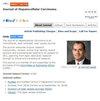Impact of Type of Lenvatinib Resistance on Prognosis and Second-Line Regimen in Patients with Virus-Associated HCC
IF 4.2
3区 医学
Q2 ONCOLOGY
引用次数: 0
Abstract
Background: Lenvatinib is the first-line treatment option for patients with advanced hepatocellular carcinoma (HCC); however, the impact of lenvatinib resistance on patient prognosis is unknown.Methods: We recruited all patients with advanced HCC who received first-line lenvatinib treatment between February 2019 and February 2023 at two medical centers in China, according to the selection criteria. The patients were divided into primary and secondary resistance groups based on tumor progression within 3 months. The Kaplan-Meier method was used to calculate progression-free survival (PFS) and overall survival (OS). Logistic regression and Cox proportional hazards models were used to explore factors influencing drug resistance and prognosis. The study end points were drug resistance, PFS, and OS.
Results: A total of 531 patients met the study criteria, with 169 (31.8%) and 362 (68.2%) patients in the primary and secondary groups, respectively. An alpha-fetoprotein (AFP) concentration > 400 ng/mL was an independent risk factor for primary drug resistance. Patients in the primary group had a significantly shorter median OS (11.0 vs 31.0 months, P< 0.001) than those in the secondary group. The 1-, 2- and 3-year cumulative survival rates in the primary group were 46.3%, 22.2%, and 10.1%, while those in the secondary group were 82.3%, 59.1% and 44.9%, respectively. Compared to tyrosine kinase inhibitor (TKI) monotherapy, longer median PFS (4.0 vs 7.0 months, P=0.008) and OS (11.0 vs 23.0 months, P=0.024) were achieved with the combination of a TKI plus a PD-1 inhibitor as a second-line therapy after lenvatinib resistance.
Conclusion: There is a high rate of primary resistance to lenvatinib in patients with HCC and the prognosis for those with primary resistance is poor. TKI combined with PD-1 inhibitors should be preferentially recommended for lenvatinib-resistant patients.
伦伐替尼耐药类型对病毒相关性 HCC 患者预后和二线治疗方案的影响
背景:来伐替尼是晚期肝细胞癌(HCC)患者的一线治疗方案,但来伐替尼耐药对患者预后的影响尚不清楚:来伐替尼是晚期肝细胞癌(HCC)患者的一线治疗方案,然而,来伐替尼耐药对患者预后的影响尚不清楚:根据选择标准,我们招募了2019年2月至2023年2月期间在中国两家医疗中心接受来伐替尼一线治疗的所有晚期HCC患者。根据3个月内肿瘤进展情况将患者分为原发性耐药组和继发性耐药组。采用卡普兰-梅耶法计算无进展生存期(PFS)和总生存期(OS)。采用逻辑回归和考克斯比例危险模型探讨影响耐药性和预后的因素。研究终点为耐药性、PFS和OS:共有 531 例患者符合研究标准,其中 169 例(31.8%)和 362 例(68.2%)分别属于初诊组和复诊组。甲胎蛋白(AFP)浓度> 400 ng/mL是原发性耐药的独立风险因素。初治组患者的中位生存期(11.0 个月 vs 31.0 个月,P< 0.001)明显短于复治组。初治组患者的1年、2年和3年累积生存率分别为46.3%、22.2%和10.1%,而复治组患者的1年、2年和3年累积生存率分别为82.3%、59.1%和44.9%。与酪氨酸激酶抑制剂(TKI)单药治疗相比,在来伐替尼耐药后,TKI加PD-1抑制剂联合治疗作为二线治疗,可获得更长的中位PFS(4.0个月 vs 7.0个月,P=0.008)和OS(11.0个月 vs 23.0个月,P=0.024):结论:来伐替尼在HCC患者中的原发性耐药率很高,原发性耐药患者的预后较差。对于来伐替尼耐药患者,应优先推荐TKI联合PD-1抑制剂。
本文章由计算机程序翻译,如有差异,请以英文原文为准。
求助全文
约1分钟内获得全文
求助全文

 求助内容:
求助内容: 应助结果提醒方式:
应助结果提醒方式:


